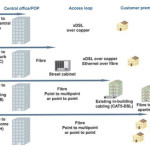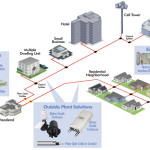There are two major standards groups for PON technology, they are the Institute of Electrical and Electronics Engineers (IEEE) and the Telecommunication Standardization Sector of the International Telecommunication Union (ITU-T). The following article is about the introduction of different PON technology.
GEPON (Gigabit Ethernet passive optical network)
- 1G / 10G symmetrical
- Update from Ethernet protocols and components, bringing economies of scale
- Highly scalable and flexible, with a cost-effective single management system
- Can realize very dense networks and serve thousands of subscribers
- Integrated support for Triple Play (internet, television and telephone), QoS (quality of service), IPTV (internet protocol television) and VoIP (voice over IP)
- Less costly than previous GPON equipment
- 10G EPON symmetrical supports 10G downstream and upstream.
- 10G EPON asymmetrical supports 10G downstream and 1G upstream.
GPON (Gigabit PON)
- IP-based protocol, used in most deployments and accommodates today and tomorrow’s demanding applications globally
- 2.488Gbps downstream and 1.244Gbps upstream
- Mostly single fiber, although the standard is specified as both a single and multi-fiber system
- 10G PON—also called XG- PON, and based on the ITU-T G.987 standard—is designed to coexist with GPON devices on the same network
XGS-PON
- 10 Gbps symmetrical—an improvement from previous generations of XG-PON that offered only 10 Gbps downstream
- Symmetrical bandwidth is ideal for today’s business services and mobile backhaul
- Delivers four times the upstream speed of current XG-PON1 technology
- Relatively easy to scale up existing fiber networks in response to demand
- Less costly symmetrical service compared to other PON upgrade paths
- Can co-exist with current generation GPON technology
WDM PON (wavelength division multiplexed PON)
- Nonstandard type of PON, developed by specific companies
- 10 Gbps symmetrical
- Each wavelength can run at a different speed and protocol so there is an easy pay-as-you- grow upgrade
- Converges wireless and wired services for distribution
- Reuse of existing FTTH infrastructure may be limitedTemperature control is a challenge because of how wavelengths tend to drift with environmental temperatures
NG-PON2
- 40 Gbps symmetrical—possibly 80 Gbps in future
- Extremely high bandwidth, multiple wavelengths and software-defined networking allow NG-PON2 to use a single fiber for different purposes
- Hybrid with time and wavelength division multiplexing approach
- NG-PON2 and GPON can share the optical distribution network (ODN), benefiting operators who combine business and residential services
- Optics that can dynamically tune to a provisioned wavelength (“channel bonding”) enable a wide range of business, consumer and wireless-wireline services at relatively low operating costs








